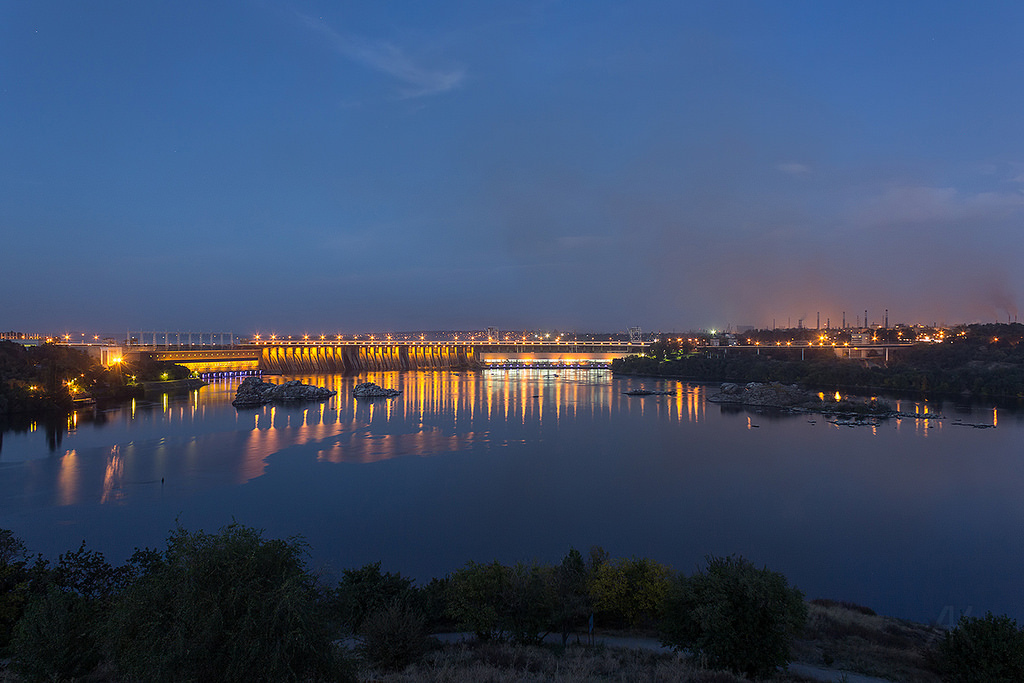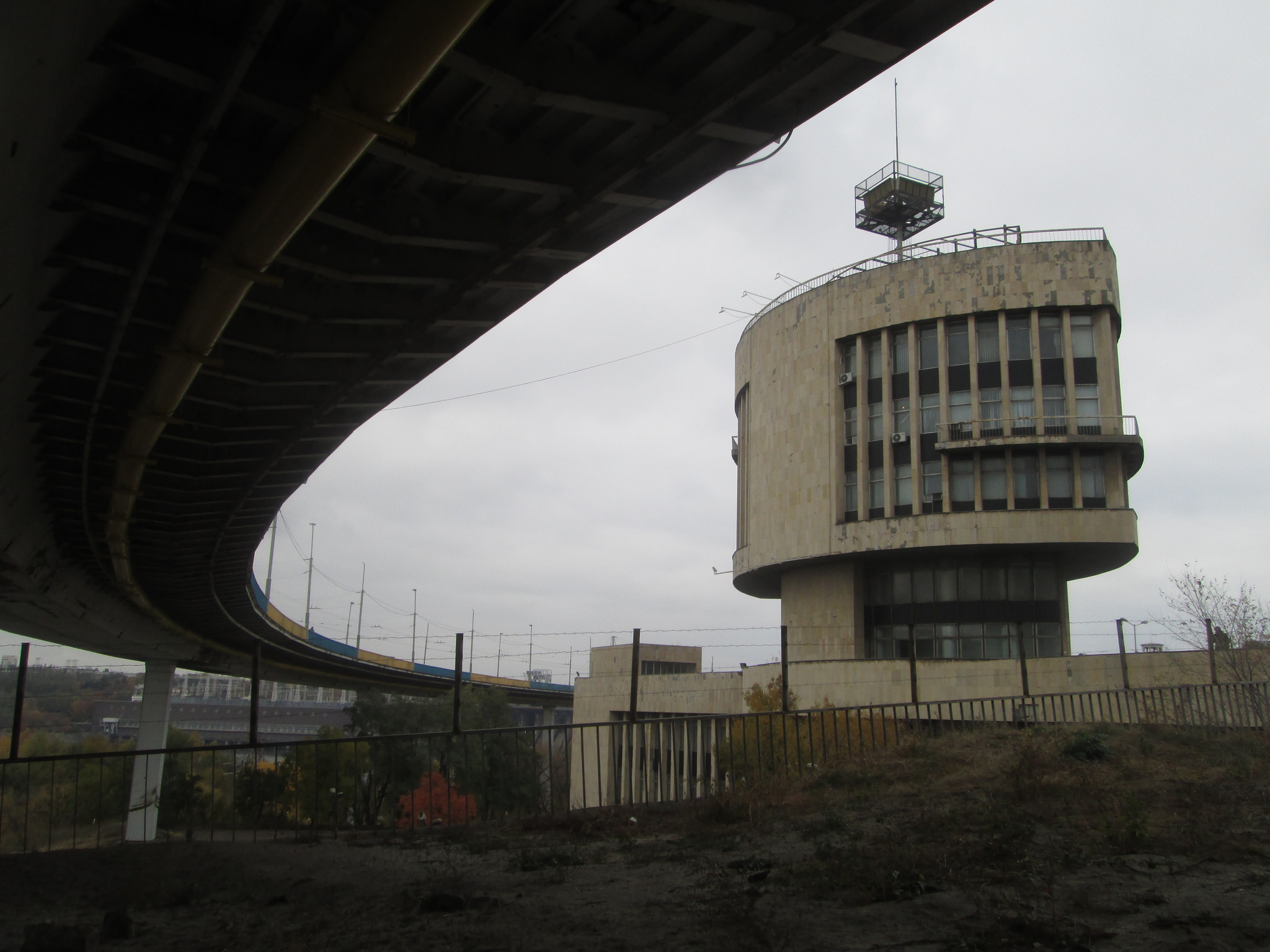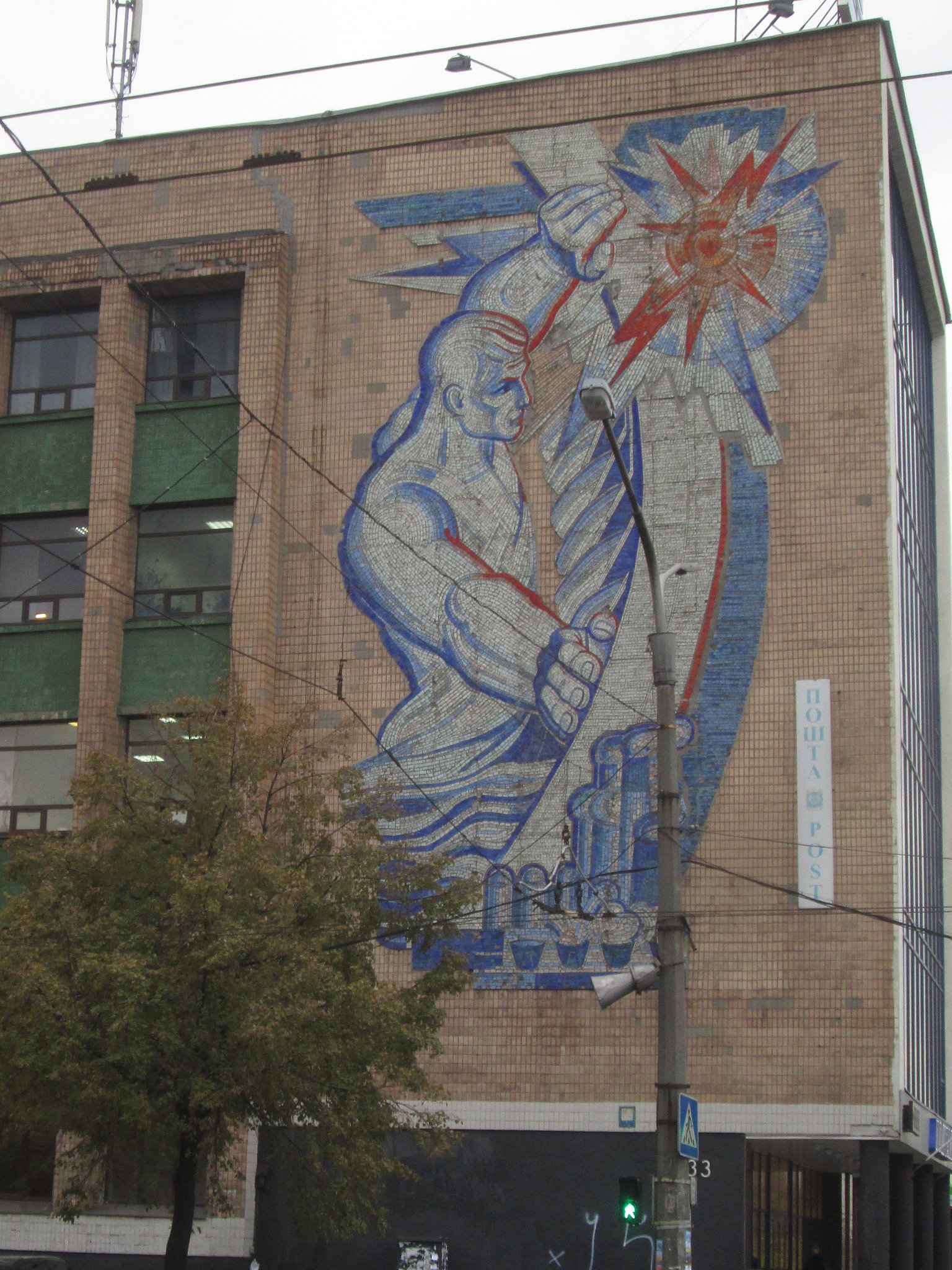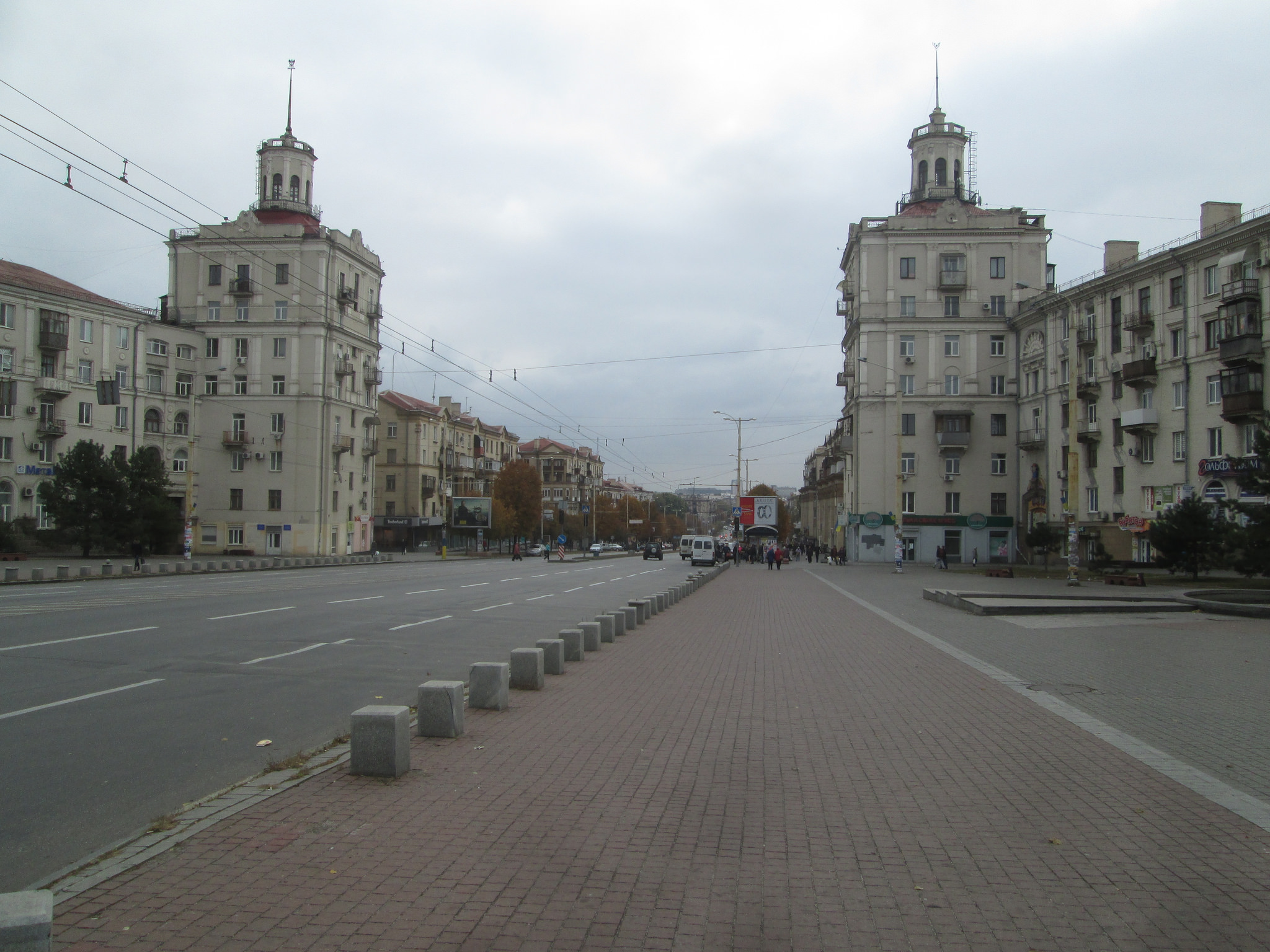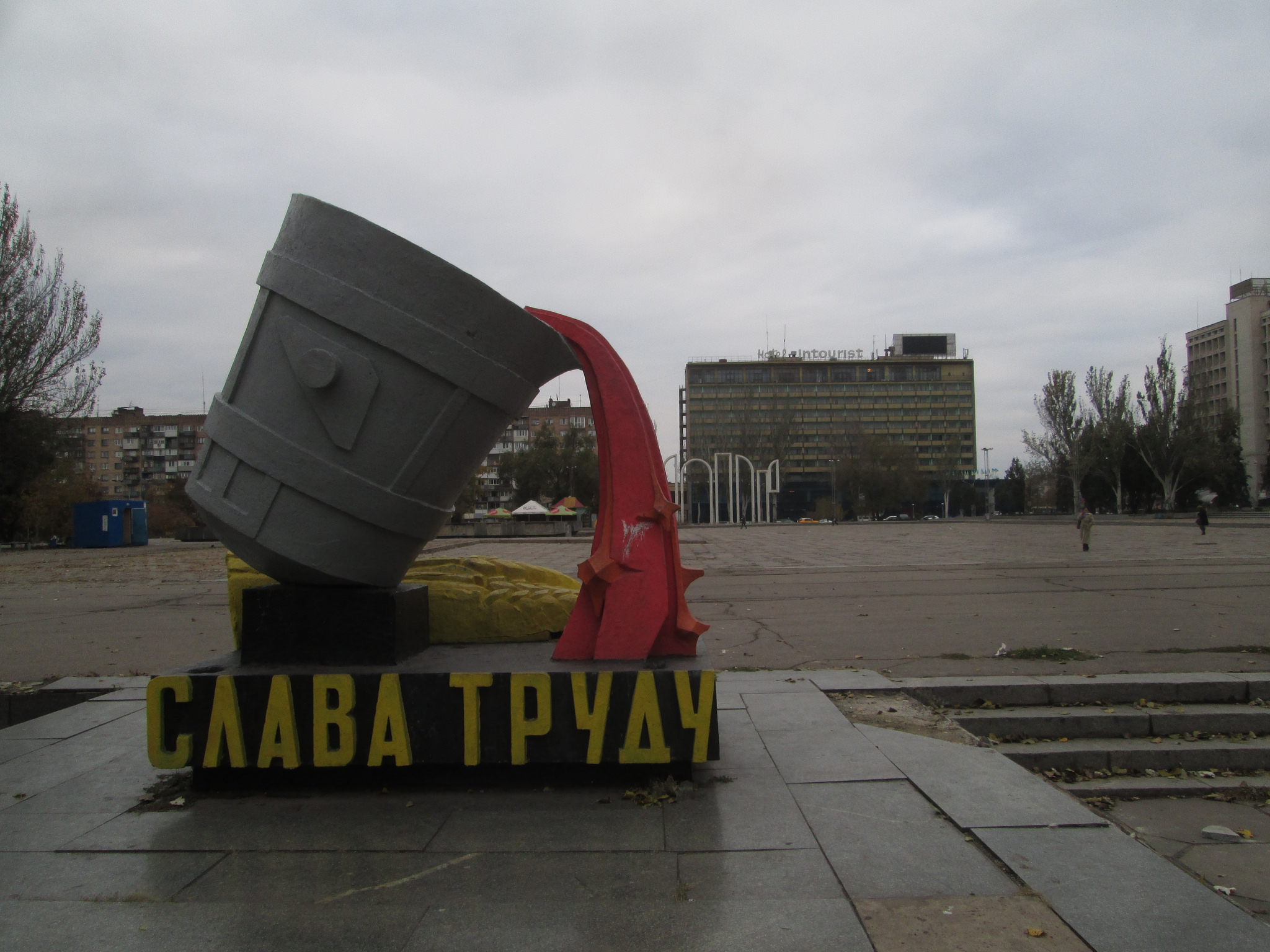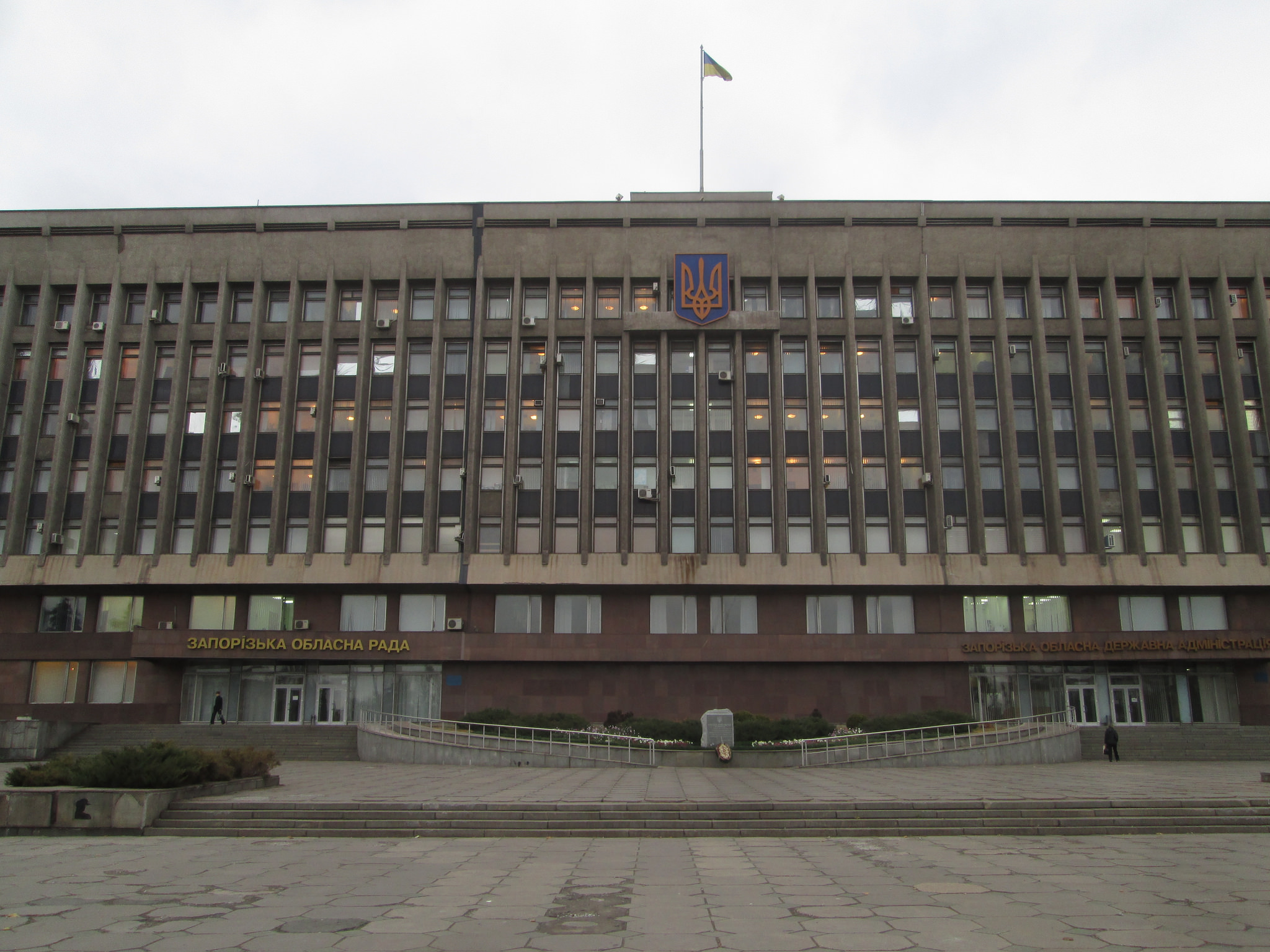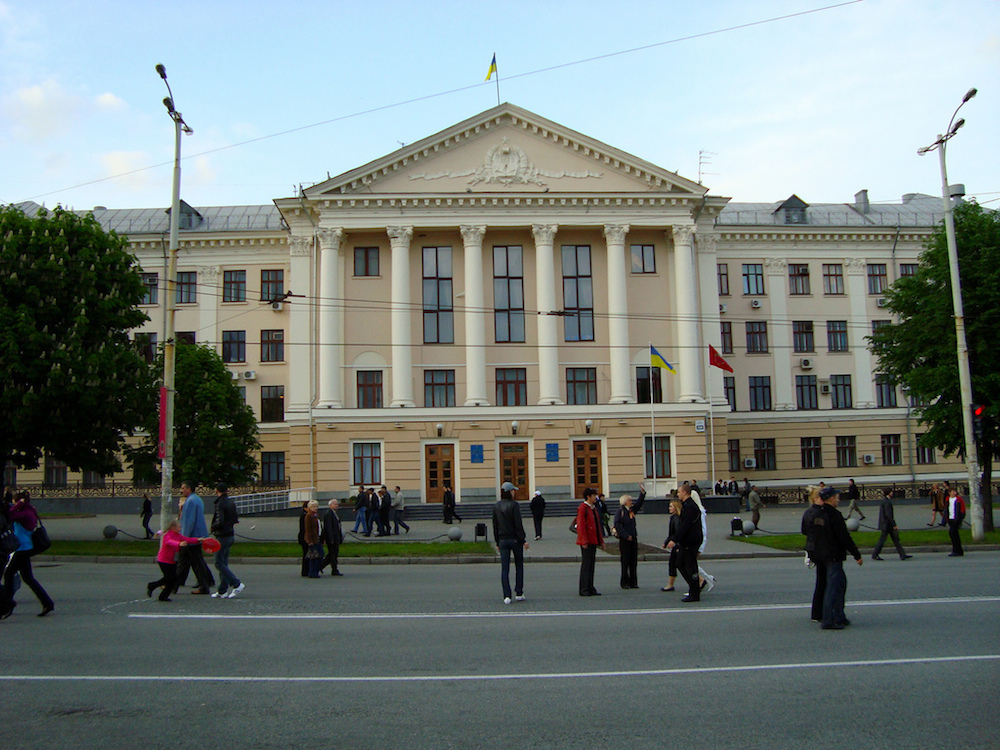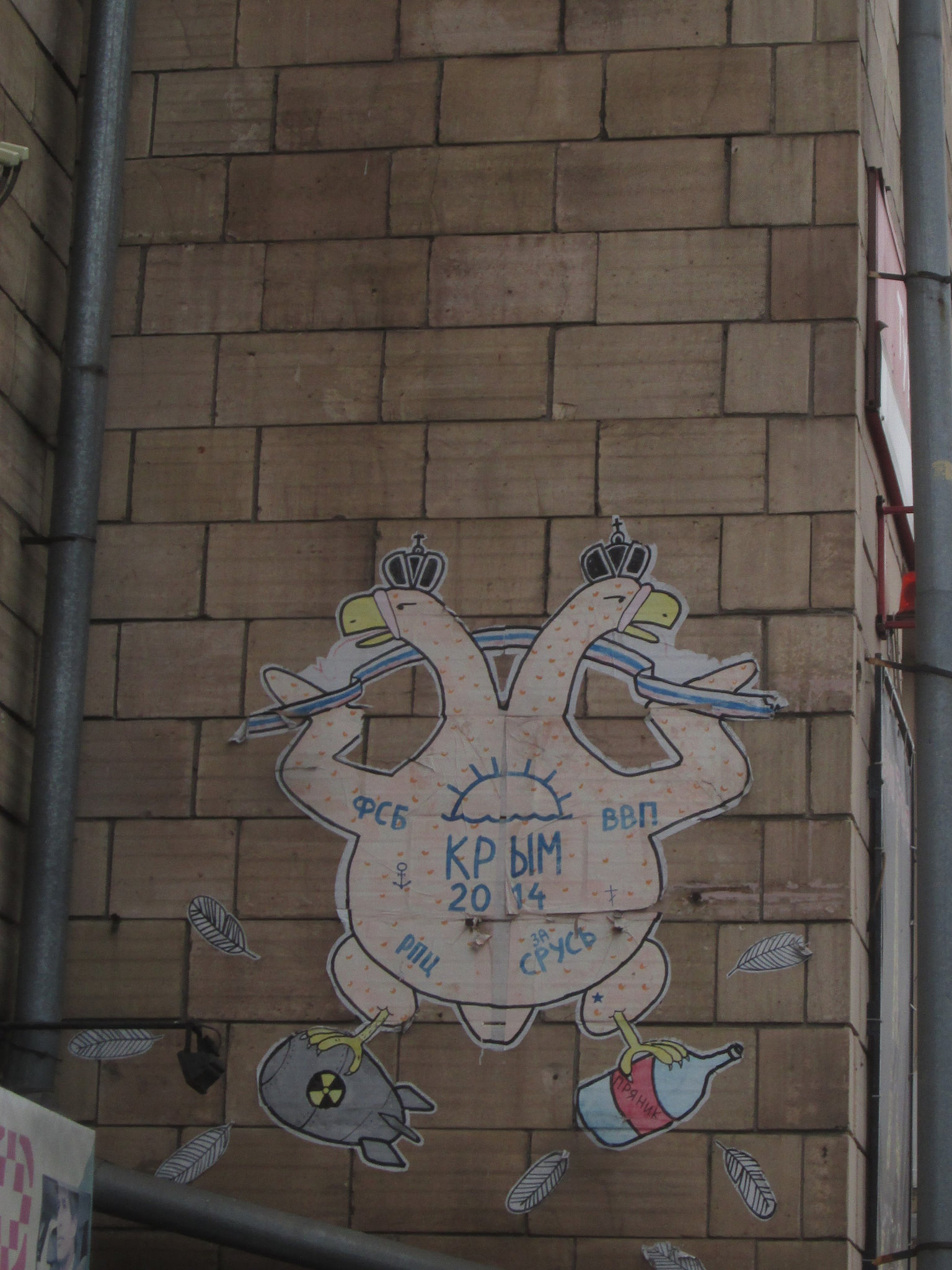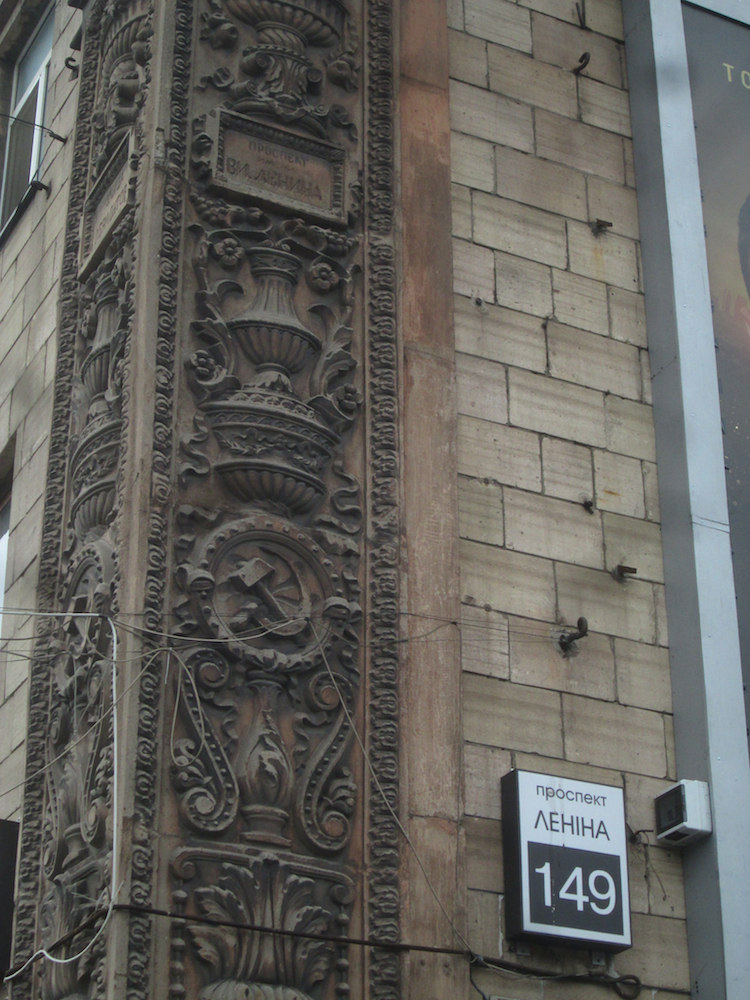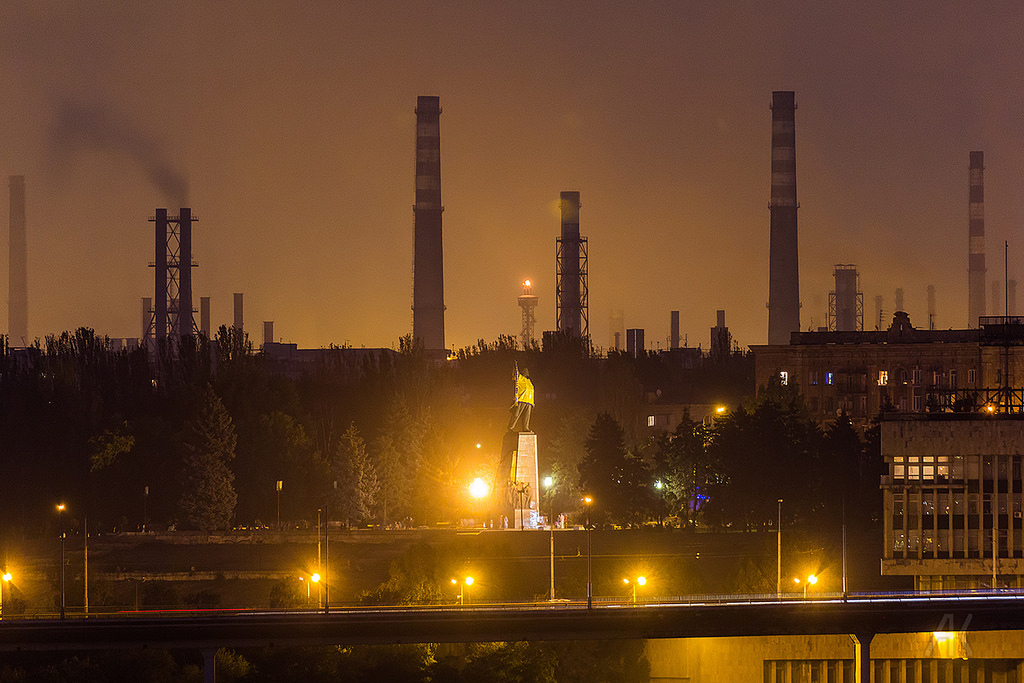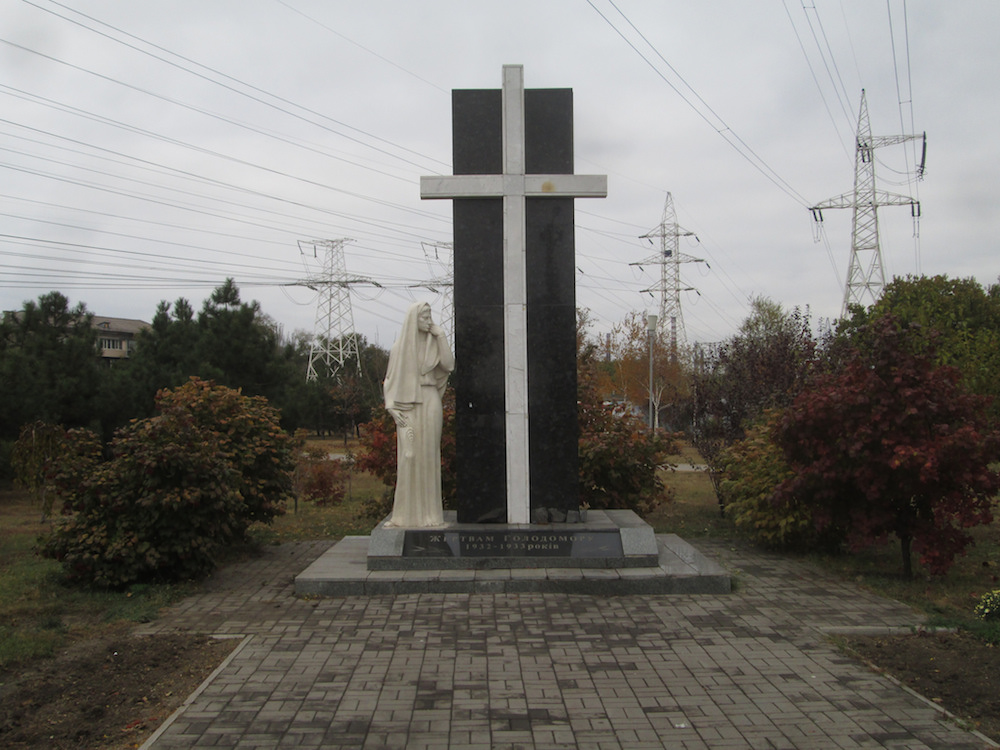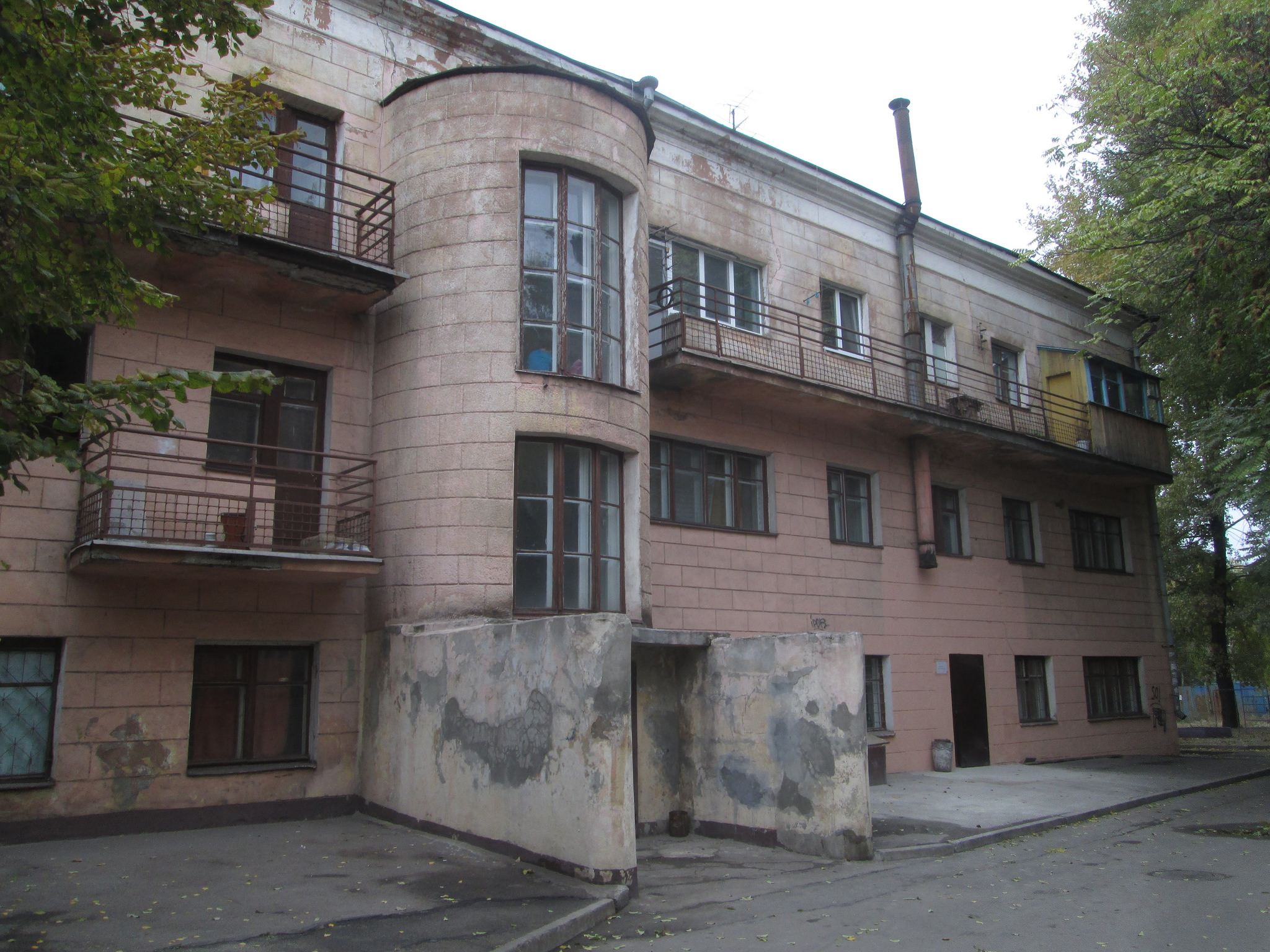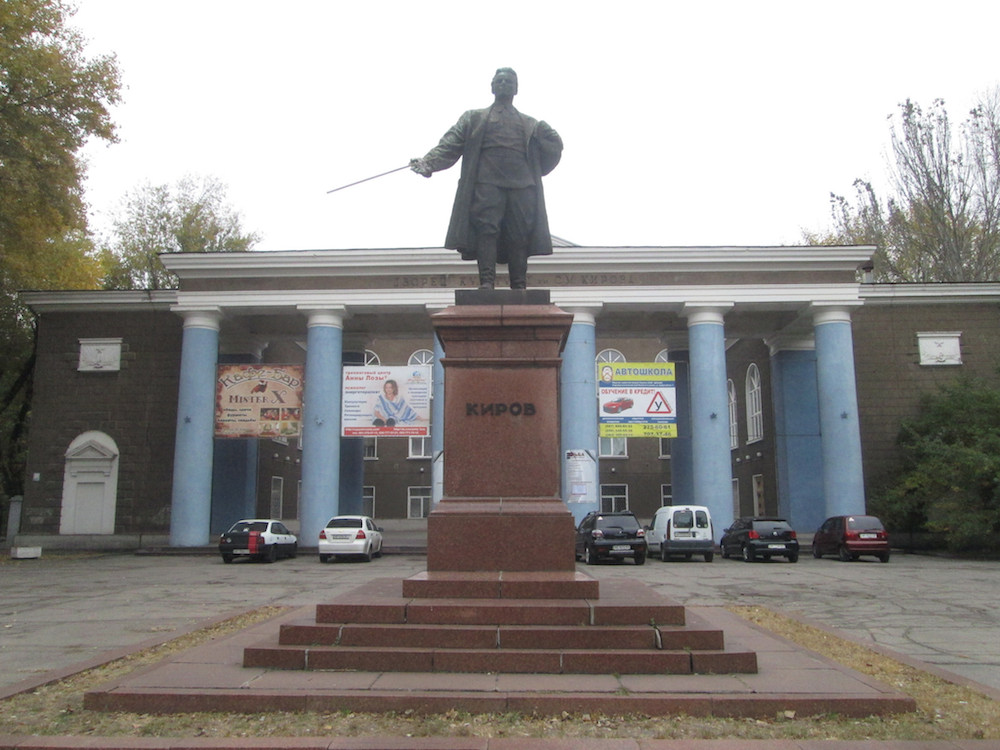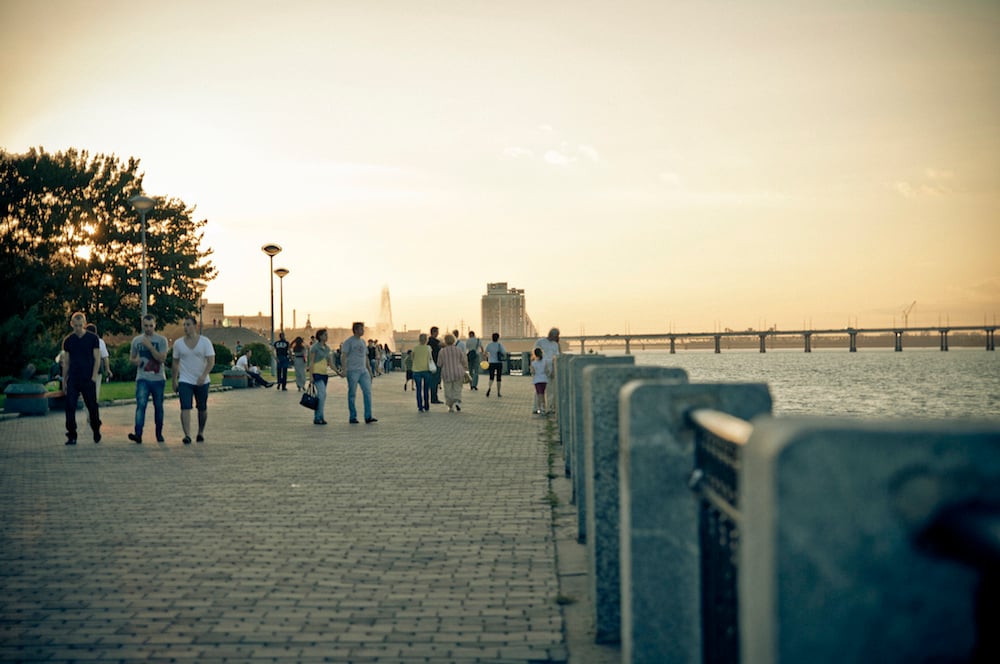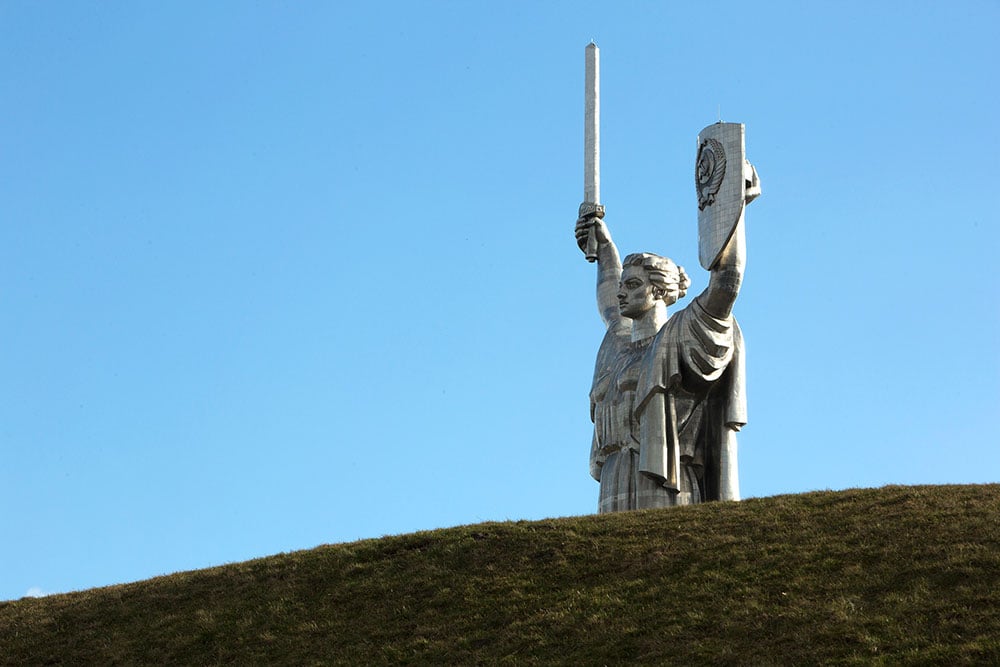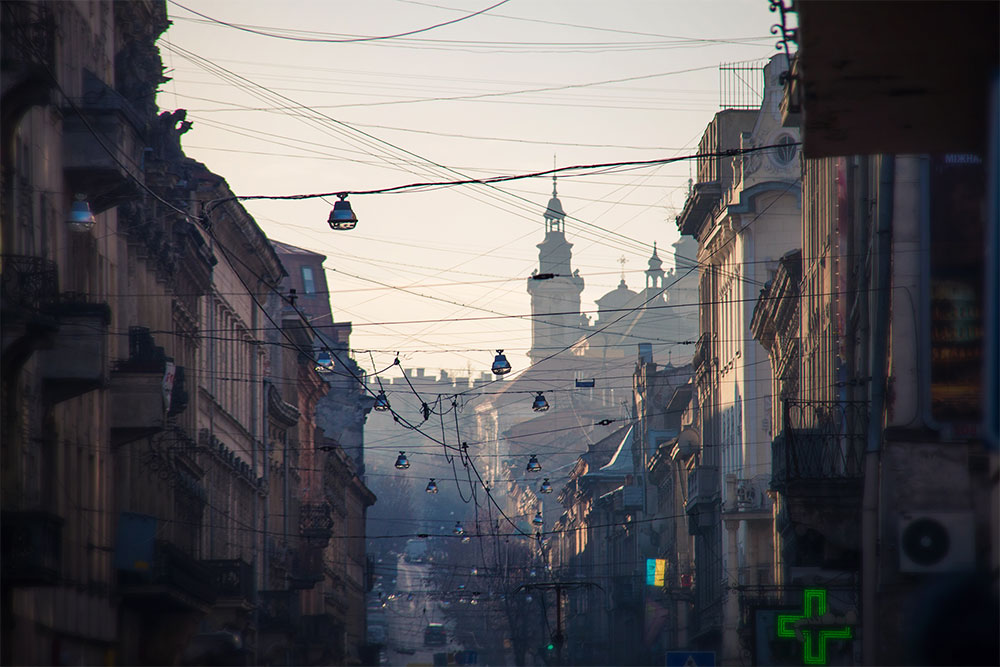Letter from: Owen Hatherley visits Zaporizhia, Stalinist city on the Dnieper
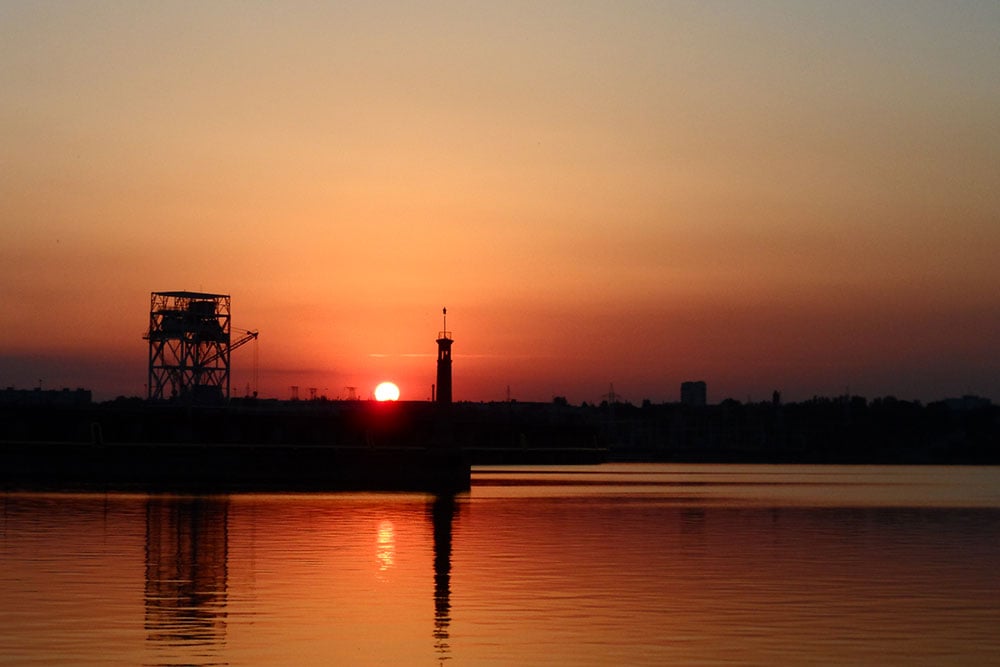
The largest remaining statue of Lenin in Ukraine was removed from its pedestal in Zaporizhia last week, the latest victim of the Ukrainian ban on Soviet symbols. But how do you go about “de-communising” an almost entirely Stalinist city?
At the time of writing, the statue of V. I. Lenin in Zaporizhia is the last major edifice of the Bolshevik leader left standing in the centre of a major Ukrainian city. By the time you read this it may have been pulled down, but right now, it still commands an enormous public square.*
The first notable thing about this bronze likeness of Vladimir Ilyich is what it’s wearing. Draped over his suit is a large yellow bib, like a high-vis jacket, which features both the Ukrainian coat of arms and the logo of Ukrop (Dill), an oligarch-sponsored nationalist party, and his outstretched hand is carrying a Ukrainian football scarf. This replaces the first new outerwear V. I. received post-Maidan, when a traditional embroidered Vyshyvanka was lowered by crane onto the giant figure. The gesture of that was an unusual attempt in Ukraine to create genuine consensus — the wishes of those who would defend the statue weren’t insulted, as it was neither defaced or demolished, and those who would tear it down could see it wasn’t allowed to stand inviolate, but was draped in Ukrainian symbols.
In fact, given Lenin’s role, pointed to by none other than V. V. Putin, of bringing Odessa and Donbass into a unified, sovereign Ukraine, against the objections of many Bolsheviks, the costume had some historical justice. The replacement with the sponsored jacket and scarf is a little more derisive, though as the critic and documentary film-maker Oleksiy Radynski argues, “It’s actually more appropriate — he’s wearing football gear and he has who is sponsoring him on his jacket, so he looks like a real worker.” Anyway, this is one of Zaporizhia’s less controversial statues — in 2010, a new statue of Stalin was erected by the local Communist Party, albeit removed soon after following vandalism.
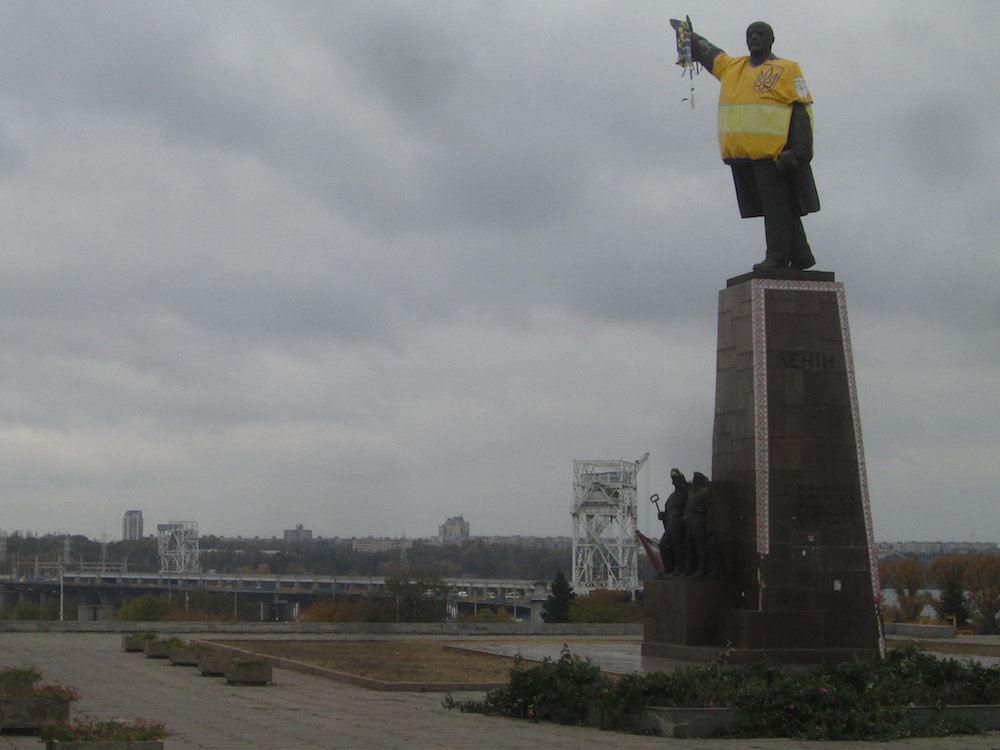
As for the statue itself, it has it all — the gigantic scale, the heroic scowl, the red granite plinth (now with a dressing of embroidery) featuring a crowd of smaller workers crowding around the feet of the giant leader. Lenin makes the “look here, see what we have wrought!” gesture common to many of the tens of thousands Lenins, although this specific one is not one of the standardised Lenins that were churned out in factories. The significance comes in the inscription and the thing to which he is pointing. The Ukrainian-language inscription is the famous slogan “Communism = Soviet Power plus Electrification of the Whole Country”, a slogan which is more complex than it appears; it didn’t mean “cables plus one-party state” so much as that the direct democracy of workers’ councils connecting with the decentralised nature of a national electrical grid would create the new society, an earlier variant of the Fully Automated Luxury Communism young folk in the west like to make memes about. But this was to be enabled by the sort of big, state-sponsored heavy industrial tech that the great man is pointing to — that is, the structure officially called DniproHES in Ukrainian, but most famous just as the Dnieper Dam, one of the largest dams ever constructed. Lenin is pointing right at it, across the gigantic square, and the pylons, wires and gantries around the structure poke up into the air around him, as if he’s the dictator of electricity.
The Dnieper Dam was so famous and so publicised in international Soviet propaganda of the 1930s as to have been specifically sniffily dismissed by Orwell. In the USSR, and not just in Soviet Ukraine, it was completely ubiquitous, featuring on countless reliefs (on a block of flats in Dnipropetrovsk, in Metro stations in Moscow and Kiev), on stamps, on badges. It was — though this was seldom mentioned — a major project of Leon Trotsky’s, who campaigned for it after his demotion from the Politburo, and similarly inconveniently, its technology, engineering and senior personnel were almost entirely American, largely courtesy of General Electric. After it was opened, it generated more power than the entire infrastructure of the pre-1917 Russian Empire; the industrial base of the city was expanded further by Zaporizhstal, a large, and also American-designed, steelworks.
First the foreign engineers and experts, and only then the workers who built all of this were housed in an extension of the small industrial town of Alexandrovsk, which was renamed post-1917 — the new name means “beyond the rapids”, referring to the currents that power the dam’s generators. The new city was masterplanned by Viktor Vesnin (who also designed the dam’s long, ribbon-windowed power-house) along Constructivist lines as a “Sotsgorod”. After destruction in the war, the dam was extended, and later, a futurist administration block was built alongside and a flyover was built on top — a spindly construction that rattles every time a bus or a lorry goes across. To actually get a full view of the dam, you have to go down to the riverbank, or go to the other famous thing here — Khortisya Island, known as the base of the Zaporizhian Sich, a self-governing Cossack state dissolved in the 18th century, then claimed by every conceivable political trend in Ukraine in the succeeding 300 years. It has one of those typically Soviet “folk architecture museums” approximating what their encampment might have looked like, and a full view of the monumental curved concrete wall of the Dam. The likely replacement for Lenin will, apparently, be a Cossack hetman.
The only way to “de-communise” a city such as this would be to raze it to the ground
The planning of the city, however, will still be around the dam. Zaporizhia centres around a typical Stalinist magistrale, an example of Soviet imperial baroque at its most stupefying — a long, wide boulevard which begins near the railway station and then after several miles terminates at Lenin. This is no longer called Prospekt Lenina on Google Maps (where it has reverted to its original name of Prospekt Sobornyi), but it is on all of the street signs, many of which are built onto the buildings, and decorated with golden swags. After a couple of days in Zaporizhia it becomes clear that the only way to “de-communise” a city such as this would be to raze it to the ground.
A tour of Lenin Prospekt might begin at at the other end to Lenin, at Central Square, in front of the Hotel Intourist, as it is still called. This is a large and dour plaza, flanked mostly by government buildings and two symmetrical, fortress-like precast concrete blocks of flats for the better class of Zaporizhian. Government buildings stand on the other side, in the slightly classicised, stone-clad Soviet variant of International Style modernism, and a mural shows a muscleman heroically harnessing the power of DniproHES. A small monument of molten steel being poured stands in one corner of the square, with the legend “GLORY TO WORK” on one side and a sheaf of wheat on the other. Along the Prospekt, there are posters reading “FOR PEACE AND STABILITY – ZAPORIZHSTAL”. The post-Party of Regions Opposition Blok easily won the elections here last autumn, and Zaporizhstal’s chief engineer was elected as mayor. It’s a post-Soviet company town. Zaporizhstal’s assets are held by a company headquartered in Guernsey, and not much of its wealth has made its way to the rusting, crumbling city where the steel is actually made. It’s a story which could be told anywhere in Russia or Ukraine, and no political force seems to be willing or able to challenge it.
It’s thug baroque, with heavy columns, beefy pediments and abrupt portals
Much unlike Dnipropetrovsk, only two hours west by train, you can count the new buildings in Zaporizhia on one hand, and none are notable. The Stalinist USSR was also a profoundly unequal society, but trickle-down there meant at least the swaggering grandiosity of Lenin Prospekt, built up largely in the early 1950s. Every baroque trick of perspective and symmetry is brought in, with towers, urns, archways, turrets, spires, fluffy stucco hammers and sickles and burly male and female steelworkers in the place where there should be cherubs and angels. It’s thug baroque, with heavy columns, beefy pediments and abrupt portals. You can see here that the Khrushchev critique of architectural “excess” had a point, given the proliferation of superfluous details — on one corner, two Roman temples flank each other on top of two blocks of tenements.
Step into the courtyards, and though the scale is maintained, everything else is more informal — brick and stucco replaces tile and granite, and there’s as much green space as in a post-1956 modernist microrayon. There’s plenty of amenities, cinemas, theatres, concert halls, mostly neoclassical — the Dovzhenko Cinema features a lovely metal bust of the film director and relief sculptures of workers and peasants; it also features a patriotic poster commemorating the “heavenly hundred”, the most explicit sign of Ukrainian patriotism I come across in the city. Graffiti, always a good measure, is conflicted — “white power” on one tenement courtyard is crossed out and replaced with “USSR”, “ATO” (Anti-Terrorist Operation, the official name for the counter-insurgency in Donbass) is crossed out elsewhere, there are stencils of Shevchenko, and a stencil of a Tsarist eagle seizing Crimea, holding a nuclear bomb in one talon and a bottle of vodka in the other.
If these blocks were anywhere west of the Elbe they’d have a preservation order, a Docomomo listing and a commemorative book
A bridge over the railway, offering views of Zaporizhstal in full blast, spewing out into the atmosphere (and you can taste it) and a tiny memorial to the Great Famine of 1933, leads to the Sotsgorod, or Sotsmisto in Ukrainian. This is a complete late 20s/early 30s modernist housing estate, comparable in its completeness and scale to the Berlin estates of Bruno Taut from the same era, which are UNESCO-listed and restored. Some of Sotsmisto was reclad after 1945 to make the design heavier and more monumental, but you can still see what it is clearly enough. One part consists of a dozen or so free-standing, low-rise, deck-access blocks with curved, glazed stairwells, and pedestrian space around. These blocks have faced a variety of treatments, some classicised, some left alone, some given plasticky reclads more recently, but their architectural expressiveness is still clear. If they were anywhere west of the Elbe they’d have a preservation order, a Docomomo listing and a commemorative book. The centrepiece of the Sotsmisto is a crescent, clearly recalling the Horseshoe Estate in Berlin, but with open colonnades, a simple garden filled with trees, and an advanced state of dilapidation, with balconies filled in and extensions added. It also features the only poster for a political party I’ve ever seen in Ukraine that is on someone’s flat rather than on a billboard; a faded image of the Communist Party leader Petro Symonenko. At the parliamentary elections of 2012, his recently banned party got 21% here; in 2014, just under 10%.
Sotsmisto too has its amenities. “Citizens of the USSR have the right to work” reads the pompous Russian inscription opposite the Kirov Palace of Culture, unpromisingly. They had the right to other things too, and concerts and suchlike are held here. Appropriately, then, someone has put a baton in the hand of the statue of Sergei Kirov that stands in front of this neoclassical temple, so that he looks either like a conductor or a magician. This sort of gentle pisstaking, seen also in the changing outfits of the nearby Lenin, seems a much more genuinely democratic, “anti-totalitarian” approach than pulling down monumental statues to build new ones. This history is remembered with a certain critical distance, but it isn’t stripped away — in a city so totally Soviet as this, how could it be?
However sensible the city’s relation to its past, especially in comparison with the hysteria elsewhere, its status in the present is less clear. Obviously, this mainly working class city is not made up of nostalgic Stalinists (though there are clearly some), not Banderites (of which election results and political actions suggest there are very few), and not of liberal democrats either (of which there may be still fewer). There was never much question of this Russophone city becoming part of “Novorossiya”, and while pro-Russian protests did take place, they were very small; the example of Donetsk, very nearby, was clearly not terribly persuasive. Communist iconography is built into the fabric of this city, and will remain so; but voting loyally for the representatives of a company which keeps the fruits of your labour in Guernsey doesn’t suggest an acute class consciousness.
*The Lenin statue was pulled down on March 17.
